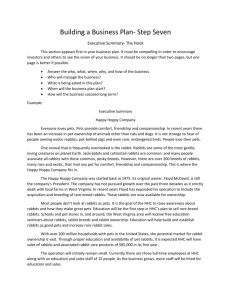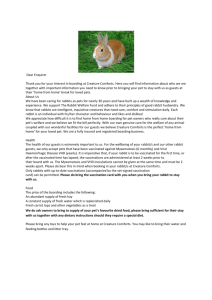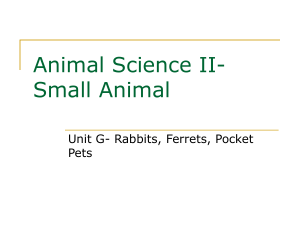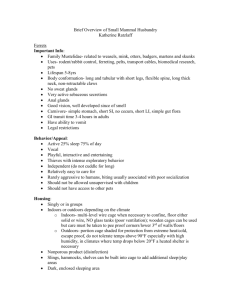Major Uses of Pocket Pets
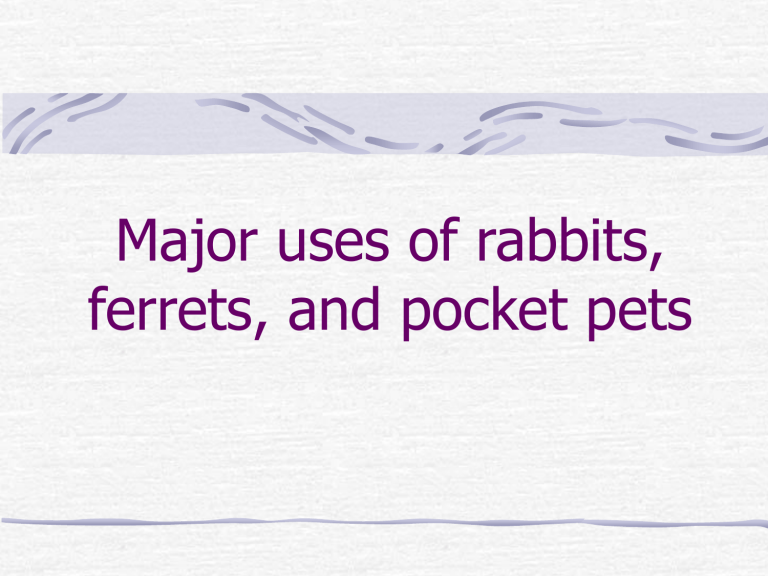
Major uses of rabbits, ferrets, and pocket pets
Rabbits
Meat-New Zealand is the most used rabbit for commercial meat production
High in protein, but low in cholesterol, fat, and sodium
Very palatable
Rabbits
Research and laboratory use.
Florida White was developed as a small meat rabbit and small laboratory animal
Used to produce disease fighting antibodies, to study reproduction, and to research several human diseases
Rabbits- research
Skin irritation tests to test the reaction of chemicals on the skin
Rabbits
Fur/wool-divided into four types
Normal- regular rabbit
Rex- short
Angora- rabbit wool (Giant Angora is the major breed used for wool production)
Satin is a mutation fur that is smaller in diameter and has a transparent outer shell
Rabbits
Compared to sheep’s wool, rabbit’s wool is finer, lighter, warmer, and softer. Does not cause irritation to skin or as scratchy
Used in the manufacturing of clothing, toys, coats, hats, gloves
Rabbits
Pets- with diversity in size they can fit into different home situations
Trainable to use litter box
Require little special care
Clean, gentle, and lovable pets
Hamsters
Used in medical research since 1931
Found that they could be tamed and made into a pet
Golden hamster is the most abundant hamster used for research and pets
Dwarf/small desert hamsters make good pets, but because of their smaller size, children have more problems handling them.
http://user.tninet.se/~uhe658x/gfx/hamster.jpg
Gerbils
Japanese scientists were the first to breed in captivity because they were easy to work with. They are gentle, active during the day, have no special food or housing requirements, drink little water, virtually odorless, and would seldom bite
These qualities also led to their popularity as pets http://www.petoffice.co.jp/mbl/ph/zukan/mini300jp g/gerbil.jpg
Rats
The white albino rats have been of major importance in medical, biological, and psychological research
Used in developing drugs, studying diseases, nutrition, aging, and other topics
Rats
Albinos
They are intelligent and have the ability to learn so have been used in behavioral studies
Colored rats especially have been accepted as pets
Mice
Used for medical and biological research, especially with hereditary studies
Pet mice are relatively free of disease, and when handled frequently, show little tendency to bite or escape
Guinea pigs
Bred originally for meat production and still used by the native people of Ecuador, Peru and Bolivia as a food source http://www.lvma.org/images/gpig.jpg
Guinea pigs
Used in laboratories for research on pathology, nutrition, genetics, toxicology, and serum development
Used also as a pet http://www.streetfarmcottages.co.uk/images/Photos/Guniea%20pig.JPG
Chinchillas
Used as a source of fur for thousands of years
Brought to California from South
America to breed for their fur
Many furs are sold as a group
Requires 120 to 150 pelts to make a full-length coat
Used as pets since the 1950s http://www.distrivictoria.com.ar/images/otras_mascotas/chinchilla.jpg
Ferrets
Recently been found to be wonderful pets, but have a musky smell and need to be descented.
Males also need to be castrated
Used in the 1800s for rodent control. The ferrets would run into holds and run the rodents out and leave a scent behind that would trigger fear http://www.soaringeagle.org/images2/ferret.jpg
Ferrets
Used to help wire airplanes in hard to reach places
Used in scientific research because they catch the same colds as humans http://www.noahs-ark.org/photos/ferret.jpg


